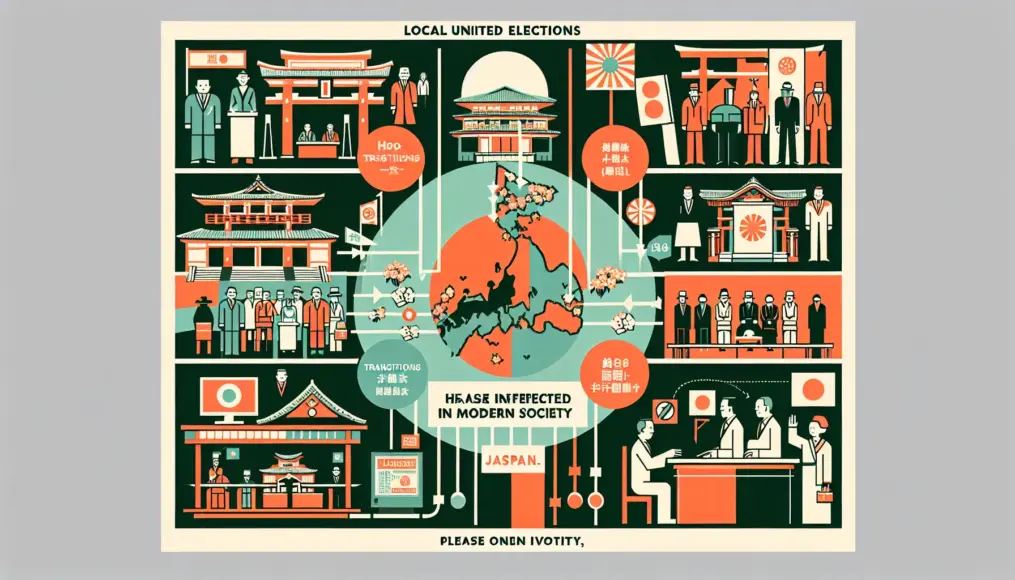Local unified elections are significant events that greatly influence regional politics. With deep historical roots, their importance continues to grow in contemporary society. In particular, the post-war evolution of political structures and the development of local governance have dramatically transformed the way elections are conducted.
In this article, we will delve into the background and impact of local unified elections, as well as the changes in electoral systems over time. We’ll also explore the trends among major political parties and shifts in civic engagement, examining how modern elections are evolving. By understanding these factors, we can better appreciate the significance of these elections in our lives.
Elections are a topic that directly affects our daily lives. Let’s take a moment to consider how future local unified elections will unfold.
- Historical Background and Impact of Local Unified Elections
- Evolution of Electoral Systems and Characteristics of Modern Elections
- Trends Among Major Political Parties and the Importance of Civic Participation
The Historical Background of Local Unified Elections
Local unified elections have played a crucial role in Japan’s political landscape. Particularly in the post-war era, the development of the political system and local autonomy has had a significant impact. Understanding these historical contexts allows for a deeper insight into the current electoral system and its significance.
After World War II, Japan underwent numerous reforms to establish a new political system. During this process, the importance of local governance was reemphasized, leading to the establishment of mechanisms that reflect the voices of local communities. This laid the foundation for local unified elections and encouraged greater participation from residents.
The Development of the Post-War Political System
In post-war Japan, the political system was extensively reexamined as a reflection of the lessons learned from the war. With the aim of solidifying democracy, reforms were initiated to strengthen the authority of local governments. In this context, local unified elections began to play an increasingly important role. They created an environment where community members could select their representatives through elections.
The strengthening of local autonomy has encouraged greater political participation among residents, leading to policies that are more responsive to local needs. This, in turn, has enhanced the transparency and accountability of local governments, contributing to regional development.
- The impact of post-war political reforms on local governance
- Mechanisms that promote political participation among residents
- Enhancements in the transparency and accountability of local governments
The Advancement of Local Autonomy
Local autonomy serves as the fundamental framework for implementing policies tailored to regional characteristics and needs. In post-war Japan, local governments have been able to exercise self-determination, allowing for the pursuit of community-centered policies. The advancement of such autonomy has further underscored the significance of local unified elections.
As the independence of local governments grows, residents find it easier to voice their opinions in politics, strengthening efforts to address local issues. Local unified elections are vital mechanisms that support these movements and contribute to community development.
For readers interested in further understanding the backdrop of local governance and election systems, we recommend checking out this article, “Exploring the Functions and Impacts of Unified Local Elections.” This piece delves into the historical evolution of the electoral system and the importance of civic participation, providing valuable insights into the significance of local unified elections.
- The impact of the framework of local governance on regional policies
- The importance of elections in reflecting residents’ voices
- Strengthening efforts to resolve local issues
The Evolution and Impact of Electoral Systems
The system of local unified elections has evolved over time, shaped by efforts to ensure transparency and fairness in politics. These reforms are vital steps in reflecting the voices of community residents in political decisions and have played a significant role in the development of local governance.
Today’s electoral system inherits lessons from past reforms while facing new challenges. As demands for fairer elections and improved voting environments grow, it’s important to examine how the evolution of these systems is affecting local communities.
The History of Electoral Reform
Electoral reform has been a critical theme in post-war Japan. Notably, reforms made from the 1950s to the 1980s were essential measures aimed at enhancing the transparency and fairness of elections. Initially, there were efforts to revise electoral districts and improve voting methods, establishing a framework that better reflected the opinions of local residents.
Additionally, systems were put in place to ensure the independence of election management, creating an environment where elections could be conducted fairly. As a result, the reliability of local unified elections improved, encouraging greater political participation among residents.
- The Background and Goals of Post-War Electoral Reform
- Improvements in Voting Methods and the Reflection of Local Residents’ Opinions
- Enhancing Reliability through Ensuring Independence in Election Management
Features of Modern Electoral Systems
Modern electoral systems have undergone significant changes due to the widespread use of the internet and advancements in information technology. The introduction of electronic voting and online voting procedures has enhanced the convenience of voting, particularly encouraging participation from younger generations.
Moreover, information about elections is more readily available online, contributing to greater transparency. However, new challenges have also emerged, such as the spread of fake news and biased information, highlighting the need for further evolution of electoral systems.
If you’re interested in this topic, we recommend checking out the article “Exploring the Cultural Impact of Election Campaigns and Political Activities.” It delves deeper into how political activities influence Japanese culture and how changes in the electoral system impact society.
- Enhanced Voting Convenience Due to Internet Proliferation
- Encouraging Political Participation Among Younger Generations
- Addressing Fake News and the Evolution of Electoral Systems
Trends and Strategies of Major Political Parties
The trends of major political parties during local elections serve as significant indicators of political change. Parties are working to strengthen their support base by understanding the needs of local residents and developing effective campaign strategies. By reflecting on historical transitions, we can gain insight into how the current political landscape and the strategies of various parties have been shaped over time.
In this section, we will explore the historical backgrounds of major parties and the modern political strategies that have emerged from them. By examining how these parties have evolved and the approaches they take in local elections, we can gain a clearer understanding of the overall electoral picture.
Historical Changes of Major Political Parties
Japan’s major political parties have undergone various transformations within the post-war political framework. Notably, reforms from the 1950s brought significant changes to party structures and policies. The early parties focused on stability in response to the impacts of war, but over time, they began to pursue diverse policies that better reflected local voices.
Since the political fluidity of the 1990s, new parties have emerged, intensifying competition with established ones. As a result, each party has needed to craft policies tailored to regional characteristics and devise effective election strategies.
- Evolution of Major Post-War Political Parties and Their Background
- Diversification of Policies Since the 1950s
- Intensified Party Competition After the 1990s
Modern Political Strategies
Today, major political parties are expected to develop policies that accurately address the needs of local residents. In their campaign strategies, a community-focused approach is emphasized, with parties proposing concrete measures to tackle local issues. This enables them to garner support from residents and strive for victory in elections.
Moreover, the utilization of social media and digital platforms has advanced, leading to the adoption of different techniques compared to traditional campaign methods. This shift has particularly strengthened outreach efforts to younger generations, fostering increased political participation.
For those interested in gaining a deeper understanding of modern political strategies, we recommend this article: “How Much Does It Cost to Run for Election?”. It provides a detailed breakdown of the costs associated with campaign activities and essential points to consider when contemplating candidacy, offering valuable information to prepare for upcoming elections.
- Importance of Community-Focused Policy Proposals
- Utilization of Digital Media in Modern Election Campaigns
- Strengthening Outreach to Younger Generations and Promoting Political Participation
Changes in Voter Behavior
Voter behavior is a crucial aspect of the democratic process during local elections. In recent years, the fluctuations in voter turnout and the significance of citizen participation have garnered attention, as these factors are heavily influenced by the political climate and social trends. When voter turnout increases, the voices of the community are better represented, making it essential for citizens to actively engage in the electoral process.
In this section, we will explore the changes in voter behavior through the lens of voter turnout trends and the importance and challenges of citizen participation. This will help us understand the impact of voting behavior on local politics and reaffirm the role of citizens in upcoming elections.
Trends in Voter Turnout
Over the past few decades, voter turnout in local elections has fluctuated due to various factors. Notably, there has been a decline in voter turnout among younger demographics. This trend is believed to stem from a waning interest in politics and a lack of trust in the electoral process.
However, there are instances where awareness about elections rises. When local issues or significant policies become focal points, voter turnout tends to increase. In such cases, residents are more motivated to vote to ensure their opinions are reflected in the outcomes.
- Historical fluctuations in voter turnout and their causes
- Impact of declining voter turnout among younger demographics
- Influence of key policy issues on voter turnout
The Importance and Challenges of Citizen Participation
Citizen participation is a vital element in local elections. When citizens actively engage in politics, the needs and issues of the community are more effectively represented. However, there are various challenges that hinder participation. For instance, insufficient information and the complexity of the electoral process can deter citizens from getting involved.
Moreover, the significance of citizen participation extends beyond just voting; it also encompasses discussing local issues and sharing opinions. This interaction can invigorate the community and foster a better political environment.
For those interested in the evolution of voter behavior, we recommend exploring the related topic of “The Changing Age of Eligibility for Candidacy and Its Impact.” This article delves into the history of eligibility age for candidacy and its shifts, examining the effects of the current system on society and politics. By deepening the understanding of the electoral system, the importance of citizen participation will become even clearer.
- Reflection of community needs through citizen participation
- The importance of engagement beyond just voting
- Barriers to participation due to information gaps and electoral complexity
Conclusion
In this article, we explored a wide array of topics, from the historical background of local unified elections to modern electoral systems, the trends among major political parties, and citizens’ voting behaviors. We gained insights into how the development of the post-war political framework, the evolution of local governance, and changes in the electoral system have influenced political participation among community members. Additionally, we uncovered the strategies that major political parties employ as they approach contemporary elections.
We also examined the shifts in citizens’ voting behavior, considering trends in voter turnout and the significance and challenges of civic engagement. It is hoped that by actively participating in politics, local residents can lay the groundwork for building a better society. With this knowledge, we can reaffirm the importance of future local unified elections and heighten our interest in regional politics.
- Local unified elections have been shaped by their historical context and changes in the system.
- The strategies of major political parties and citizens’ voting behaviors will influence upcoming elections.
- There is a need to understand the importance of civic participation and reflect local needs.
It’s essential to maintain an interest in local politics and to participate actively. We’d love to hear your thoughts and opinions in the comments!



Comment